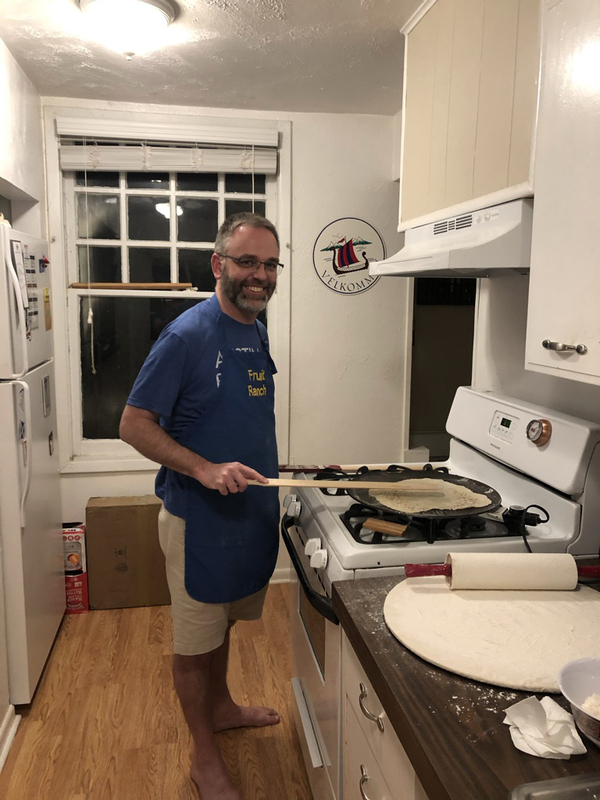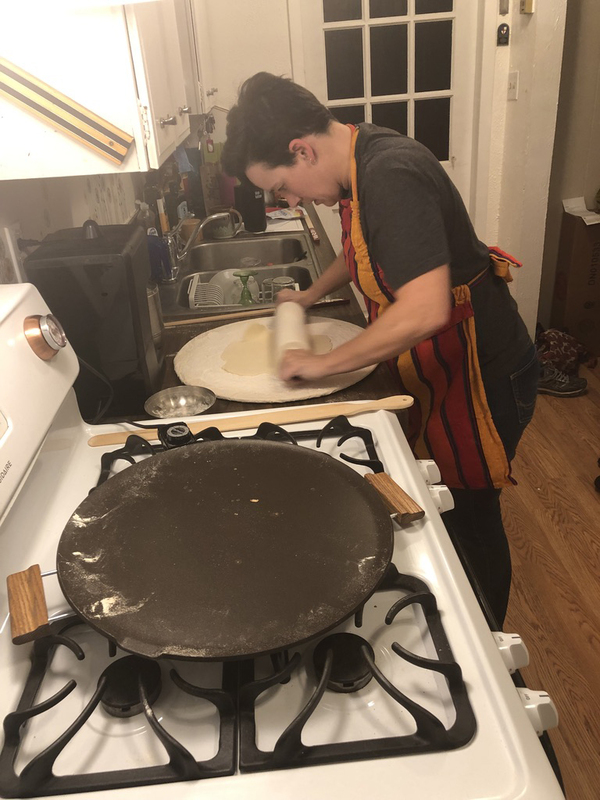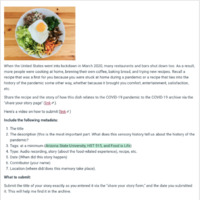Item
Creating New Traditions in a Pandemic
Title (Dublin Core)
Creating New Traditions in a Pandemic
Disclaimer (Dublin Core)
DISCLAIMER: This item may have been submitted in response to a school assignment. See Linked Data.
Description (Dublin Core)
One of the traditions in my family is to make lefse, a type of Norwegian flatbread, at Christmas time. This tradition was started by my grandmother, because it was one of the foods that she associated with her childhood Christmases as the child of Norwegian and Swedish immigrants. Every year, no matter what was going on, we gathered together as a family at the start of the Christmas season to make lefse.
If you’ve made lefse before, you can attest to it being a labor-intensive process, which involves ricing pounds of potatoes, rolling out dozens of balls of dough until they are paper thin, and frying them one by one on a hot griddle. It’s one of those recipes that works better if you have several people to help. In my family, everyone had a job to do. The youngest children of the family were put in charge of popping air bubbles that rose from the dough while it cooked. The older kids took turns flouring the rolling boards and rolling out the dough. The adults were responsible for cooking the lefse, a process that involved transferring huge rounds of dough to the hot griddle using long turning sticks. Even family members who were not culinarily inclined were put to work, folding the finished lefse and packaging it up so that it could be frozen, so that it was available for Christmas morning. It was a family affair, that filled the kitchen up with laughter and stories and more than one flour fight. Family lefse day is one of the most enduring memories of my childhood.
When the pandemic made it unsafe to travel or even to visit my family, I found myself facing a Christmas without being able to participate in my family’s lefse making tradition. There were many teary video calls to family members as we all came to terms with the fact that we would be missing this tradition for the first time in nearly 40 years. At this point, after enduring months of isolation because of COVID-19, I was devastated. It didn’t feel like the holidays without this tradition and making lefse by myself felt overwhelming. I was telling my friend Mike about how sad I was over missing out on this tradition, when he offered a solution. We would both quarantine for 14 days, purchase all the ingredients we needed and have them delivered, and then he and I would make as much lefse as we could.
I was stunned by his generosity. After all, this was not his tradition. In fact, he’d never even eaten lefse before. But he saw a way that he could help a friend feel better after such a trying year. So, we did just that. With only two of us, it took us about six hours, but we ended up with nearly thirteen pounds of lefse that eventually got sent to family members in four different states. The best moment came when we all video chatted from our homes on Christmas morning, just to eat the lefse together. It was different than normal, but it was a joyous moment. Mike joined us on the call and shared some of the challenges we had making thirteen pounds of lefse in a tiny apartment in the middle of a pandemic. This year, he’s been invited to my parents’ house to join in on the family lefse making day. After all, it’s tradition.
If you’ve made lefse before, you can attest to it being a labor-intensive process, which involves ricing pounds of potatoes, rolling out dozens of balls of dough until they are paper thin, and frying them one by one on a hot griddle. It’s one of those recipes that works better if you have several people to help. In my family, everyone had a job to do. The youngest children of the family were put in charge of popping air bubbles that rose from the dough while it cooked. The older kids took turns flouring the rolling boards and rolling out the dough. The adults were responsible for cooking the lefse, a process that involved transferring huge rounds of dough to the hot griddle using long turning sticks. Even family members who were not culinarily inclined were put to work, folding the finished lefse and packaging it up so that it could be frozen, so that it was available for Christmas morning. It was a family affair, that filled the kitchen up with laughter and stories and more than one flour fight. Family lefse day is one of the most enduring memories of my childhood.
When the pandemic made it unsafe to travel or even to visit my family, I found myself facing a Christmas without being able to participate in my family’s lefse making tradition. There were many teary video calls to family members as we all came to terms with the fact that we would be missing this tradition for the first time in nearly 40 years. At this point, after enduring months of isolation because of COVID-19, I was devastated. It didn’t feel like the holidays without this tradition and making lefse by myself felt overwhelming. I was telling my friend Mike about how sad I was over missing out on this tradition, when he offered a solution. We would both quarantine for 14 days, purchase all the ingredients we needed and have them delivered, and then he and I would make as much lefse as we could.
I was stunned by his generosity. After all, this was not his tradition. In fact, he’d never even eaten lefse before. But he saw a way that he could help a friend feel better after such a trying year. So, we did just that. With only two of us, it took us about six hours, but we ended up with nearly thirteen pounds of lefse that eventually got sent to family members in four different states. The best moment came when we all video chatted from our homes on Christmas morning, just to eat the lefse together. It was different than normal, but it was a joyous moment. Mike joined us on the call and shared some of the challenges we had making thirteen pounds of lefse in a tiny apartment in the middle of a pandemic. This year, he’s been invited to my parents’ house to join in on the family lefse making day. After all, it’s tradition.
Date (Dublin Core)
Creator (Dublin Core)
Contributor (Dublin Core)
Event Identifier (Dublin Core)
Partner (Dublin Core)
Type (Dublin Core)
Text Story
Controlled Vocabulary (Dublin Core)
Curator's Tags (Omeka Classic)
Contributor's Tags (a true folksonomy) (Friend of a Friend)
Food is Life
Traditions
Generosity
Family
Collection (Dublin Core)
Foodways
Holidays
Linked Data (Dublin Core)
Date Submitted (Dublin Core)
08/02/2021
Date Modified (Dublin Core)
08/07/2021
This item was submitted on August 2, 2021 by Amy Evenson using the form “Share Your Story” on the site “A Journal of the Plague Year”: http://mail.covid-19archive.org/s/archive
Click here to view the collected data.



